The Grape vs the Grain Pairing with Food
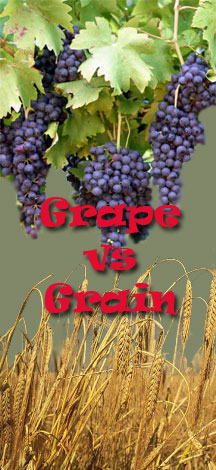 In round one of the Grape vs the Grain we discussed the styles of wine vs the many styles of beers. We can say that beer has many more styles than wine. One reason is that beer is made from many grains. Styles will vary by the type of grains used (rye, sorghum, millet, barley, corn, wheat etc). Then the styles will further vary by the way those grains are treated, toasted, sparged and attenuated. Hops gives us an even higher variation of styles. The choice of hops, the amount of hops and when hops are added will change the style. Finally, adjuncts and by adjuncts I mean positive adjuncts. These are additions to the beer that change or increase its flavor. For example, adding coffee to a stout creates a new style, coffee stout. Adding orange to a wheat beer creates a sub-style of wheat. It would be sacrilegious to do this with wines. Adding adjuncts to wine, does not change the style, but ruins the wine. Yes, an almond Champagne is a ruined Champagne in my book.
In round one of the Grape vs the Grain we discussed the styles of wine vs the many styles of beers. We can say that beer has many more styles than wine. One reason is that beer is made from many grains. Styles will vary by the type of grains used (rye, sorghum, millet, barley, corn, wheat etc). Then the styles will further vary by the way those grains are treated, toasted, sparged and attenuated. Hops gives us an even higher variation of styles. The choice of hops, the amount of hops and when hops are added will change the style. Finally, adjuncts and by adjuncts I mean positive adjuncts. These are additions to the beer that change or increase its flavor. For example, adding coffee to a stout creates a new style, coffee stout. Adding orange to a wheat beer creates a sub-style of wheat. It would be sacrilegious to do this with wines. Adding adjuncts to wine, does not change the style, but ruins the wine. Yes, an almond Champagne is a ruined Champagne in my book.
Wine styles are based on the grapes and their region. Sauvignon Blanc varies style. A French Sancerre Blanc is mineral driven with its focus on acidity. A New Zealand Sauvignon Blanc style is aromatic, green and citrus. A California SB is fleshier and riper. Adding coffee or oatmeal into the barrels would be a huge no-no. So this leaves wine styles limited to grapes and regions. Wine making techniques can also change the style, but in comparison to beer, wine styles are fairly limited.
Grape vs the Grain round two, pairing with food.
If you have not noticed, I have put a lot of time into learning more about beer because I like to drink it. As I hang out with more brewers and cicerones, I keep hearing that beer pairs better with food than wine. I automatically cringe. My eye begins to twitch and have been known to get an asthma attack. Although I agree that beer pairs with food, I still can’t returning to my wine roots. I have written about food and wine pairing many times in the past. There are some basic rules I like to follow. What I notice when cicerones pair beer with food some of those rules are over looked. And it makes sense, they have a secret weapon, carbonation. Carbonation in beer changes everything. It allows beer to match with a greater variety of foods.
One of my rules is never pair a sweet food with a less sweet wine. With beer, that is irrelevant. When pairing a semi-sweet wine with a dish that is sweeter, the sugar of the dish makes the wine taste bitter. This could ruin a very good glass of wine. This rule doesn’t apply to beer. I had an Oktoberfest the other day while my daughter was eating doughnut holes doused in sugar and cinnamon. I took a sip of my beer and stole a doughnut hole from her plate. I was pleasantly surprised, it made a very good pairing. The beer is malty and not hoppy. The doughnut was obviously sweeter but the beer did not taste bitter. The beer had carbonation that washed away the bitterness. If it had been a wine, it would have been a different story. The most important part in pairing wine with food is acidity. However, in the doughnut example, if the wine had less sweetness, the acidity would have clashed with the sugared doughnut and the wine would have tasted bitter.
Beer lovers are proud that they can drink beer with just about any type of food. Beer pairs better with cheeses than wine. How many times have you bought a selection of cheeses and a bottle of wine. When you spread them out and started tasting them there is always one cheese in the mix that makes the wine taste bad. Wine and cheese pairing is very difficult. You have to consider the saltiness, creaminess and bitterness of the cheese and then match it to the body, the sweetness and acidity of the wine. Having one element out of balance throws off the pairing. However, with beer the pairing is a bit easier. Sure there are some no-nos to pairing beer and cheese; but for the most part, cheese matches the malty sweetness and hoppy bitterness of beer. After all, cows eat grain, they pooh and more grain grows, and beer is made from grain. I guess it is the natural cycle that makes beer and cheese and excellent pairing.
So far, beer seems to pair with food better than wine. It has malty rich sweetness to pair with desserts and cheeses. It has hops that pairs with spicy foods, something that wine struggles with. The toasting of the malt pairs with charred foods or have the maillard effect. Carbonation allows beers to pair with more foods because the bubbles naturally cleanse the palate and wash away any unpleasantness. All this being true, beer is easier to pair with food than wine, but is it better? There are two things that really bother me..
First, beer is filling. You have a beer or two and depending on the style, you’re done. There is a reason our ancestors referred to beer as liquid bread. They say the Egyptian pyramids were built on beer. Slaves would get paid 2 loaves of bread and two jugs of beer. They would drink the beer and make more beer from the bread. Obviously the beer was filling, had carbohydrates and provided enough energy for them to continue working. The issue is food tastes a lot better when you are hungry. That is why so many of the élite fine dining restaurants serve small portions. They want us to enjoy the nuances and perfect combination of what is on the plate. When eating at a steak house, the first several bites of that bone in rib-eye is absolutely delicious, although it is still good as you continue to eat, but not as good as the first bites. That is because you are starting to fill up. Beer fills you up quicker while eating. Although the malt, hops and carbonation make for an excellent pairing, that feeling only lasts for a short time. Food coma soon takes over.
Wine is less filling. Sounds like a Miller-lite commercial. But it’s true. Take myself, I can drink a while lot more wine because it does not have carbohydrates which give an empty full feeling. Wine can keep flowing all night and I don’t get full. I get buzzed, but not full from the wine. This allows for a longer experience. It also lets us try different foods and pairings in one sitting. This is why we can have 6-8 course menus in a fancy restaurant. Put beer in the same menu and you will be struggling to finish. I guess the positive side would be you wouldn’t feel hungry after eating in a chic restaurant if you used beer. This takes me to issue number two.
There are more possibilities when pairing beer with food, however I feel as though it loses that “Aha” moment. I have had some great beer and food pairings. Many were downright delicious, like banana waffles and sabayon and a Belgian Witbier. However, when I have had wine and food paired perfectly, the experience went beyond downright delicious. When all components on a plate come together with the wine’s body, tannin, flavor and acidity; the experience is magical. All of a sudden you begin to take smaller bites to savour the pairing as long as you can. Because there are so many more variables in wine and food pairing it is easier to go astray. However, when everything aligns it is pure magic. Such a pairing has nuances and subtleties that might be missed with beer. Carbonation the secret ingredient, can be the culprit. It washes away what might make the pairing an “aha” moment.
In conclusion, beer has so much more diversity than wine. Beer pairs with more types of foods and is excellent with cheeses. Wine has its difficulties because of the many variables that can skew a pairing. However, when wine is paired excellently with food, there is no comparison. Wine allows for a longer and more fulfilling experience. Good beer pairings are easy to come by> Beer pairs well with so many of the foods we eat on a regular basis burgers, steaks, pastas and other comfort foods. Although it is more difficult to come by a perfect wine and food pairing when it does occur it is transcendental. My verdict is: Beer is easier to pair with food, but wine is better!
By the way, Beer lovers I am giving a class on the history of craft brewing on November 8th & November 15th at two of our newest restaurants, Sea180 Coastal Tavern & OB Warehouse. Get tickets now!

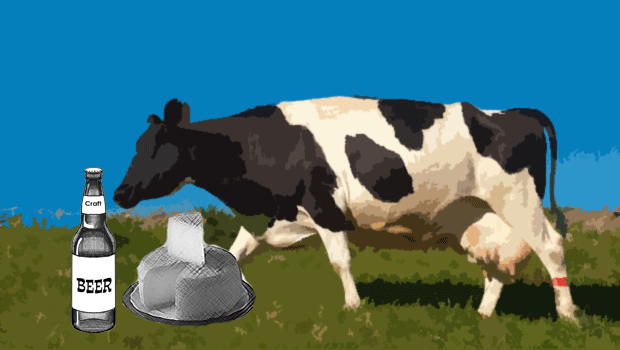
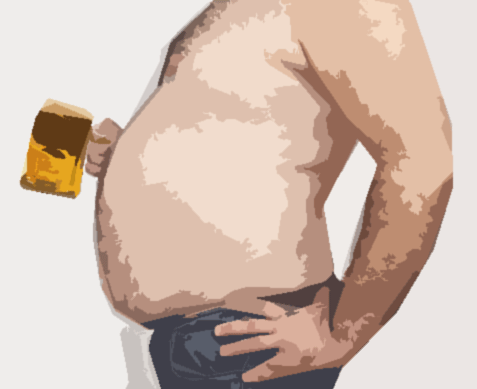
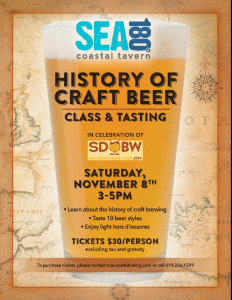

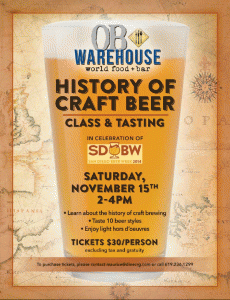








5 Comments
Riccardo Margheri
I hadn’t had the pleasure to read Your previous rticle, but do You really think that the diversity of grapes, territories, winemaking styles doesn’t pair the (huge) differences You can enjoy in the beer world?
Just my opinion of course
Kind regards
Riccardo Margheri
Maurice
i am a wine guy, and I wish I could say wine had more diversity unfortunately, it does not. The worse thing is that wine has become much more homogenized over the years as winemakers are trying to create a style that is more acceptable in the market place. Beer has a whole lot more styles. Breweries are not bound by vintages and are based on a commodity that can be bought at any time of the year. This has allowed breweries to experiment with different styles without having to worry about loosing a harvest. Sure there may be more variations, but there are very few A HA moments.
Riccardo Margheri
There’s something true in what You write, but looks like (maybe…) more an American situation, because in Europe there are plenty of family run small wineries whose only possibility to remain on the market is to develop, exploit show a diversity that can only be linked to the specific territory, or terroir if You please. Maybe not all the public will enjoy that, but at least when You produce just 50.000 btls You can say You make something unique. So there are plenty of product oriented (sometimes even too much…) stuff to choose within. Don’t know how much of that arrives in US, but I feel confident I could bet You would enjoy things that right now You do not even suspect they exist 🙂
Cheers!!
Kind regards
Riccardo Margheri
Riccardo Margheri
What You write is true, but looks like being partially a US problem. In the sense that (i.e.) here in Italy there are plenty of tiny family run wineries working their own fruit, whose only possibility to remain on the market is valorizing their own unicity, It is true that sometimes they are even too much product (and tradition as well) oriented, but there is an astonishing and enjoyable variety to play with. Not that with this I don’t like drinking craft beers… 🙂
Cheers!
Riccardo Margheri
Riccardo Margheri
What You write is true, but looks like being partially a US problem. In the sense that (i.e.) here in Italy there are plenty of tiny family run wineries working their own fruit, whose only possibility to remain on the market is valorizing their own unicity, It is true that sometimes they are even too much product (and tradition as well) oriented, but there is an astonishing and enjoyable variety to play with. Not that with this I don’t like drinking craft beers… 🙂
Cheers!
Riccardo Margheri